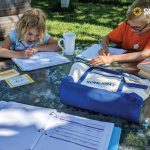
Did you know that in Tennessee homeschooling for 180 four-hour days is equivalent to a year of public school education? This is true from kindergarten through high school. Many states have similar attendance requirements.
At first I was stunned that my kindergartner had to complete course work for only four hours a day. The kids in our neighborhood are gone from 7:30 in the morning to 3:30 in the afternoon. What in the world were the students boarding the yellow bus doing the rest of the school day?!
Continue reading below or listen here:
What Do School Kids Do All Day?
The answer to this question, though initially puzzling, quickly became clear to me. At school there are lines for everything:
- the bus or pickup line
- the bathroom
- the lunch line
There is a ton of time spent waiting. Sometimes it is waiting for others to finish an assignment. Other times it is waiting for a bell to ring signaling a chance to run and play. Regardless, it is time that we as homeschoolers spend enjoying free play, completing chores around the house, exercising at the local park, and being social in the community. No lines and no waiting means more margin in our day! And homeschooling can get done really quickly.
What Do Homeschool Kids Do All Day?
When I began homeschooling, I was astounded that four hours a day was required. We often covered significantly more coursework than her public school peers during a much shorter time.
I continue to be amazed that the same number of hours is required of a kindergartener as a twelfth grader. Although I wanted to pursue a four-day homeschool week to increase our flexibility and family time, I was overwhelmed at the idea of adding any more curriculum-focused time to my kindergartner’s schedule during those four days.
After all, we have to meet our state requirements. How could we do that with a 4-day week?
On any given day, it takes my daughter and me approximately two to three hours to complete her kindergarten course work. Mostly, we pull the extra one to two hours of required time from reading aloud, nature study, music, or art. To get to five hours, we could work ahead in the curricula, but this is developmentally inappropriate for several reasons.
- Youngsters like my daughter learn best in small increments, rather than long drawn out episodes of stationary work.
- Continuing to work ahead without giving her time to mull over and practice the concepts she’s learning puts her at a disadvantage.
- Rushing through a literature-rich and diverse curriculum sucks the pleasure right out of homeschooling.
Here's How to Meet State Requirements with a Four-day Homeschool Week
I quickly realized that in order to actually “teach” my daughter for the required number of hours, I would need to apply a few truths that experienced homeschoolers before me have known for ages:
- Real life learning is as important—if not more important—than what’s learned in books.
- Young kids usually learn better and faster when there is movement involved.
- You don’t have to formally and traditionally school for four hours a day, five days a week.
Finding Our Way to a Four-day Homeschool Week
Taking these truths into account, I was motivated, but still a little paralyzed, with how to adjust our schedule to accommodate my state's required number of instructional hours a day. I loved the idea of a four-day homeschool week but was concerned it would make it even harder to achieve our total hour requirement.
I wasn’t adverse to year-round homeschooling (in fact that’s now what we do), but I didn’t want to spend more time on things she already knew or that would come to her more easily if given a bit more time to mature.
My epiphany came when I realized that several of the activities we already do with our extra time easily translate to learning activities: free play, trips to the park, and community involvement, for instance. A four-day school week works when I document the teaching/learning that occurs away from the curriculum. There's just so much learning happening that it's easy to meet my state's requirements!
Sometimes this learning is inspired by the homeschool curriculum, such as when we investigated early medicine after reading Mary on Horseback or practiced collecting and pressing flowers after enjoying The Boxcar Children. Other times it’s completely unrelated and gives the kids a brain break, which only enhances their learning. For example, this morning my daughter illustrated her very own picture book based on The Twelve Dancing Princesses and created an artistic work showcasing several of her favorite bible stories.
One of the best things about a full curriculum like Sonlight is that you aren’t wasting time with busy work or non-essentials. The kids aren’t burning out; instead they are staying excited about learning. Sonlight already provides tons of flexibility with both traditional table activities (handwriting) and couch time (reading). Using a four-day homeschool schedule gives us even more of a good thing!
Imagine how extra margin in your week could bless your family! Choose your 4-day curriculum here.








